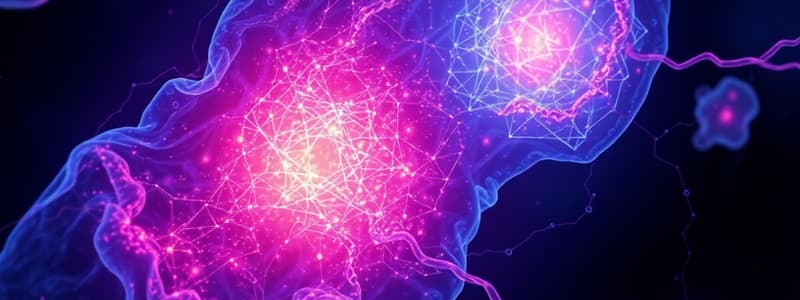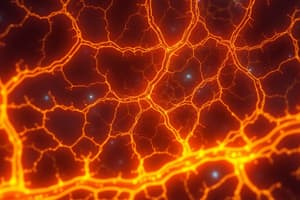Podcast
Questions and Answers
What does connective tissue primarily provide to the body and its organs?
What does connective tissue primarily provide to the body and its organs?
- Hormone production
- Flexibility and movement
- Cohesion and internal support (correct)
- Nutrient absorption
Which of the following is a key component of connective tissue?
Which of the following is a key component of connective tissue?
- Nerve cells
- Muscle fibers
- Extracellular matrix (correct)
- Epithelial cells
Which cells are considered 'fixed cells' in connective tissue?
Which cells are considered 'fixed cells' in connective tissue?
- Eosinophils
- Fibroblasts (correct)
- Lymphocytes
- Plasma cells
What is the main function of the extracellular matrix in tissues with a mechanical function?
What is the main function of the extracellular matrix in tissues with a mechanical function?
Which of these is a function of cells specialized for protection?
Which of these is a function of cells specialized for protection?
Which type of cell is primarily responsible for secreting connective tissue fibers?
Which type of cell is primarily responsible for secreting connective tissue fibers?
Which of the following fibers is a type of connective tissue fiber?
Which of the following fibers is a type of connective tissue fiber?
Which component of the extracellular matrix is known as ground substance?
Which component of the extracellular matrix is known as ground substance?
What is the function of glycosaminoglycans (GAGs) in the extracellular matrix?
What is the function of glycosaminoglycans (GAGs) in the extracellular matrix?
Which type of tissue provides a framework by connecting and supporting other tissues?
Which type of tissue provides a framework by connecting and supporting other tissues?
What is a characteristic of loose connective tissue?
What is a characteristic of loose connective tissue?
In which area of the body can areolar connective tissue be found?
In which area of the body can areolar connective tissue be found?
What is one of the primary functions of white adipose tissue?
What is one of the primary functions of white adipose tissue?
What type of connective tissue contains fine branching reticular fibers in a semi-solid matrix?
What type of connective tissue contains fine branching reticular fibers in a semi-solid matrix?
Where is reticular connective tissue primarily found?
Where is reticular connective tissue primarily found?
Which feature distinguishes dense connective tissue from loose connective tissue?
Which feature distinguishes dense connective tissue from loose connective tissue?
Which of the following is a main type of cartilage?
Which of the following is a main type of cartilage?
What type of cells are found within cartilage?
What type of cells are found within cartilage?
Which of the following tissues is considered a specialized connective tissue?
Which of the following tissues is considered a specialized connective tissue?
What are the two main types of bone tissue?
What are the two main types of bone tissue?
What is the fluid component of blood called?
What is the fluid component of blood called?
Which of the following is a blood cell?
Which of the following is a blood cell?
Which of the following is a function of blood?
Which of the following is a function of blood?
Which of the following is a type of 'transient cell' found in connective tissue?
Which of the following is a type of 'transient cell' found in connective tissue?
What is the main function of adipocytes?
What is the main function of adipocytes?
Which type of fiber gives connective tissue the ability to stretch and recoil?
Which type of fiber gives connective tissue the ability to stretch and recoil?
What is the function of macrophages in connective tissue?
What is the function of macrophages in connective tissue?
Which of the following is a location of hyaline cartilage?
Which of the following is a location of hyaline cartilage?
Which type of cartilage is found in the intervertebral discs?
Which type of cartilage is found in the intervertebral discs?
What characteristic distinguishes elastic cartilage?
What characteristic distinguishes elastic cartilage?
Where is regular dense connective tissue typically found?
Where is regular dense connective tissue typically found?
What gives irregular dense connective tissue its strength?
What gives irregular dense connective tissue its strength?
The tissue in the elastic artery is made of which type of connective tissue?
The tissue in the elastic artery is made of which type of connective tissue?
The Dermis is made of which type of tissue?
The Dermis is made of which type of tissue?
Flashcards
Connective Tissue
Connective Tissue
A group of tissues that maintain the body's form, provide cohesion, and offer internal support.
Cells found in connective tissue
Cells found in connective tissue
Includes fibroblasts, adipocytes, macrophages, mast cells, plasma cells, and eosinophils.
Extracellular matrix function
Extracellular matrix function
The main structural component found in tissues providing mechanical function (like ligaments and tendons)
Cells Function
Cells Function
Signup and view all the flashcards
Types of Connective Tissue Cells
Types of Connective Tissue Cells
Signup and view all the flashcards
Extracellular Matrix
Extracellular Matrix
Signup and view all the flashcards
Connective Tissue Fibers
Connective Tissue Fibers
Signup and view all the flashcards
Three Types of Connective Tissue Fibers
Three Types of Connective Tissue Fibers
Signup and view all the flashcards
Connective Tissue Proper
Connective Tissue Proper
Signup and view all the flashcards
Loose Connective Tissues
Loose Connective Tissues
Signup and view all the flashcards
Types of Loose Connective Tissue
Types of Loose Connective Tissue
Signup and view all the flashcards
Areolar Connective Tissue Locations
Areolar Connective Tissue Locations
Signup and view all the flashcards
Types of Dense Connective Tissue
Types of Dense Connective Tissue
Signup and view all the flashcards
Types of Cartilage
Types of Cartilage
Signup and view all the flashcards
Types of Bone
Types of Bone
Signup and view all the flashcards
Blood
Blood
Signup and view all the flashcards
Study Notes
- Connective tissues maintain body and organ form and provide cohesion and internal support.
- Types of connective tissues vary in density, cellularity, and specialization.
Overview of Connective Tissue
- Key components include water, cells, extracellular matrix, and fibers.
- Cells include fibroblasts, adipocytes, macrophages, mast cells, plasma cells, and eosinophils.
- The matrix is composed of glycoproteins, fibrous proteins, and glycosaminoglycans.
- Extracellular matrix is a main feature in tissues with a mechanical function like ligaments, tendons, and bones.
- Cells are the main feature in tissues specialized for protection or metabolic maintenance.
Connective Tissue Cells
- Fixed cells: fibroblasts, adipocytes, macrophages, mast cells.
- Transient cells: plasma cells, eosinophils.
Non-Cellular Substrate (Extracellular Matrix)
- Also known as ground substance.
- It has amorphous and gelatinous consistency and is transparent and colorless.
- Fills spaces between cells and fibers, enabling metabolite transportation.
- Large protein molecules called glycosaminoglycans (GAGs) link together to form proteoglycans, which absorb water.
- The matrix is good at resisting compressive forces.
Fibers
- Fibroblasts secrete fibers that form a supporting network for cell attachment.
- Three types exist: elastic, collagen, and reticular.
- Different combinations of these fibers create different connective tissue types.
Classification of Connective Tissue
- Connective Tissue Proper divides into Loose and Dense types.
- Specialized Connective Tissue divides into Supporting (Cartilage, Bone) and Fluid (Blood, Lymph) types.
Connective Tissue Proper
- Composed of loose and dense connective tissue.
Loose Connective Tissue
- Has numerous cells, loose fibers (thin elastin, thicker collagen), and slightly viscous fluid.
- Supports and connects other tissues to acting as framework throughout the human body.
Types of Loose Connective Tissue
- Areolar connective tissue covers muscle fibers, is under the epidermis, is in/around mucous membranes, and surrounds nerves and blood vessels.
- Adipose connective tissue that is in matrix of areolar tissue, with white and brown adipose tissues.
- White adipose tissue is 20-25% body weight, supports, thermally insulates, and stores energy.
- Brown adipose tissue generates heat and is vital for newborns.
- Reticular connective tissue contains branching reticular fibers in a semi-solid matrix.
- It contains reticular cells, monocytes, and lymphocytes.
- It is found in lymph nodes and lymphatic organs.
- Areolar connective tissue is found in skin and dental pulp.
Dense Connective Tissue
- Has elastic, dense irregular, and dense regular.
Cartilage
- Firmer than other connective tissues with cells, known as chondrocytes, within matrix of collagen and elastic fibres.
- Three types: hyaline, fibrocartilage, and elastic.
Bone
- Two types: compact and spongy.
Blood
- Composed of highly specialized watery fluid: plasma.
- Constantly circulates.
- Contains various blood cells: erythrocytes, leucocytes and platelets.
Studying That Suits You
Use AI to generate personalized quizzes and flashcards to suit your learning preferences.




